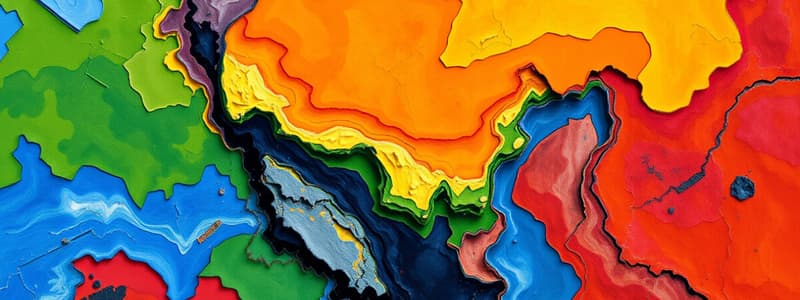Podcast
Questions and Answers
What is the primary mineral composition of the upper mantle?
What is the primary mineral composition of the upper mantle?
- 55% olivine, 35% pyroxene, 5-10% calcium oxide and aluminum oxide (correct)
- 55% calcite, 35% dolomite, 5-10% iron oxide
- 55% basalt, 35% granite, 5-10% magnesium oxide
- 55% mica, 35% quartz, 5-10% feldspar
Which layer of the Earth is known to be the only liquid layer?
Which layer of the Earth is known to be the only liquid layer?
- Inner Core
- Upper Mantle
- Lower Mantle
- Outer Core (correct)
What are the main components of the Lower Mantle?
What are the main components of the Lower Mantle?
- Olivine, magnesium, and iron (correct)
- Iron and nickel
- Silica, aluminum, and calcium
- Basalt and granite
How does Earth's magnetic field primarily get generated?
How does Earth's magnetic field primarily get generated?
What is the approximate temperature range of the Outer Core?
What is the approximate temperature range of the Outer Core?
Which layer of the Earth is the thickest, comprising about 84% of its total volume?
Which layer of the Earth is the thickest, comprising about 84% of its total volume?
What primarily causes the movement of tectonic plates in the mantle?
What primarily causes the movement of tectonic plates in the mantle?
How thick is the oceanic crust compared to the continental crust?
How thick is the oceanic crust compared to the continental crust?
What is the main material that composes oceanic crust?
What is the main material that composes oceanic crust?
What is the chemical composition of continental crust primarily made of?
What is the chemical composition of continental crust primarily made of?
What defines the upper mantle's relationship with the crust?
What defines the upper mantle's relationship with the crust?
What is the primary cause of earthquakes and volcanic eruptions?
What is the primary cause of earthquakes and volcanic eruptions?
Which component of the Earth's structure is primarily liquid?
Which component of the Earth's structure is primarily liquid?
Flashcards are hidden until you start studying
Study Notes
Earth's Structure
- Four major components: crust, mantle, outer core, inner core.
- Each layer has distinct chemical compositions and physical states impacting surface life.
- Mantle movement from core heat variations causes plate shifts, leading to earthquakes and volcanic eruptions.
Crust
- Thickness ranges from 6 to 50 km; oceanic crust approximately 5 km thick while continental crust can be up to 65 km.
- Oceanic crust consists of denser minerals than continental crust.
Continental Crust
- Formed by granitic, sedimentary, and metamorphic rocks, creating continents and continental shelves.
- Less dense than mantle material, allowing it to "float" above the mantle.
Oceanic Crust
- Composes the upper layer of oceanic tectonic plates.
- Contains pillow lavas, dike complexes, and lower crust made of troctolite, gabbro, and ultramafic cumulates.
Mantle
- Extends about 2,900 km thick, accounting for 67% of Earth's mass and 84% of its volume.
- Predominantly solid, but behaves as a viscous fluid over geological time.
- Partial melting at mid-ocean ridges produces oceanic crust, while subduction zones yield continental crust.
Upper Mantle
- Thickness of 370 km, sharing characteristics with the crust, known as the lithosphere.
- Underneath is the asthenosphere, which is partially molten.
- Composed mainly of olivine, pyroxene, and some calcium and aluminum oxides.
Lower Mantle
- Spans 1,700 km and is denser and hotter than the upper mantle.
- Solid composition mainly includes olivine, magnesium, and iron.
Outer Core
- A liquid layer about 2,100 km thick, primarily made up of iron and nickel.
- Responsible for Earth's magnetic field; liquid motion generates magnetism.
- Temperature ranges from 4,000 to 5,000 degrees Celsius.
- Contains minimal rock since the inner core melts metals into liquid magma.
Inner Core
- Not extensively covered but mentioned as being extremely hot, deeply dense, and entirely solid iron and nickel.
Studying That Suits You
Use AI to generate personalized quizzes and flashcards to suit your learning preferences.




